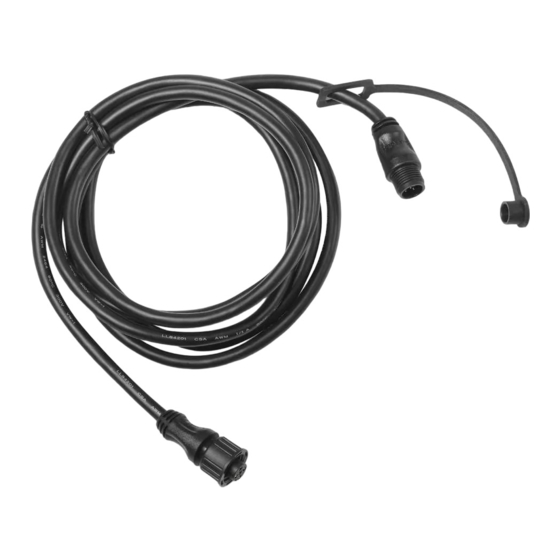- ページ 7
舶用機器 Garmin NMEA 2000のPDF 取付説明書をオンラインで閲覧またはダウンロードできます。Garmin NMEA 2000 10 ページ。 Technical reference for garmin nmea 2000 products
Garmin NMEA 2000 にも: データシート (1 ページ), テクニカル・リファレンス (30 ページ), テクニカル・リファレンス (42 ページ), 取扱説明書 (20 ページ), 取付説明書 (40 ページ), 参考 (42 ページ), テクニカル・リファレンス (20 ページ)

Weather and Sea Surface Information
The GXM 51 receives XM Weather Radio data and shows it on your chartplotter. The weather data for each feature
comes from reputable weather data centers such as the National Weather Service and the Hydrometerological
Prediction Center. (See the XM WX Satellite Weather Web site at
information.) Any weather feature can change in appearance or interpretation if the source that provides the
information changes. XM Weather Radio data is broadcast at set rates. For example, NEXRAD Radar data is
broadcast at five minute intervals. When the marine network is turned on or when a new feature is selected, the
GXM 51 has to receive new data before it can be displayed. For this reason you may experience a delay before
weather data or a new feature appears on the map.
WARNING: The XM Weather Radio data is merely supplemental and advisory in nature and is not intended to be
relied up on as safety-critical information. You should always exercise caution and common sense when confronted
with severe weather conditions.
WARNING: XM WX Weather should not be used for hazardous weather penetration. Weather information is
approved only for weather avoidance, not penetration.
Weather-Related Broadcast Rates
NEXRAD Overview
NEXRAD Description
NEXRAD Radar is a Doppler radar system that has greatly improved the detection of meteorological events such
as thunderstorms, tornadoes, and hurricanes. An extensive network of NEXRAD stations provides almost complete
radar coverage of the continental United States, Alaska, and Hawaii, and the majority of Canada. The range of each
NEXRAD is 124 nautical miles.
NEXRAD Abnormalities
There are possible abnormalities regarding displayed NEXRAD images. Some, but not all, of those include the
following circumstances:
Ground clutter
Strobes and spurious radar data
Sun strobes, when the radar antenna points directly at the sun
Military aircraft deployment of metallic dust (chaff), which can cause alterations in radar scans
Interference from buildings or mountains, which may cause shadows
NEXRAD Limitations
Certain limitations exist regarding the NEXRAD radar displays. Some, but not all, are listed here for your awareness:
NEXRAD base reflectivity does not provide sufficient information to determine cloud layers or precipitation
characteristics (for example, determining between hail and rain).
GXM 51 Installation Instructions
Feature
NEXRAD
Cloud Tops
Storm Cells
Lightning
Wind
Pressure
Hurricanes
Visibility
Fronts
Sea-Surface Temperature
Wave Height
Wave Period
Wave Direction
Current Conditions
Forecasts
Sea-Surface Conditions
http://weather.xmradio.com/weather
Broadcast Rate
(minutes)
5
15
1.25
5
12
12
12
12
12
12
12
12
12
12
12
12
for more
